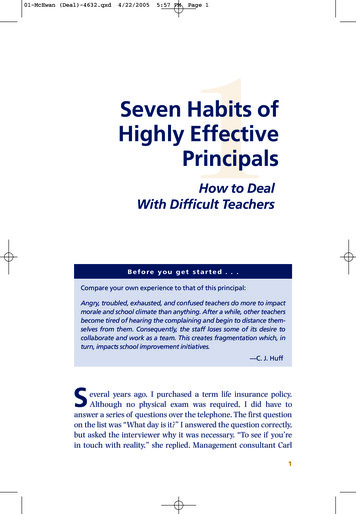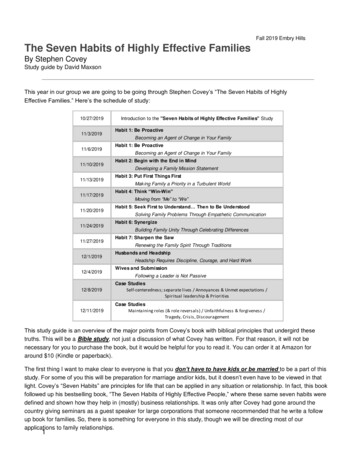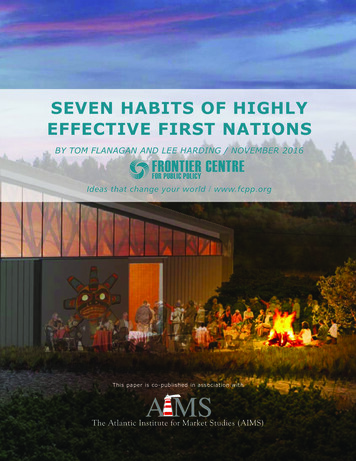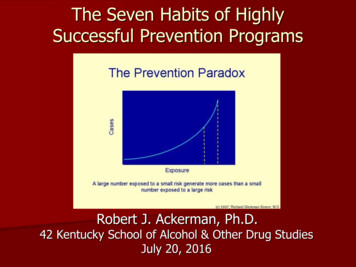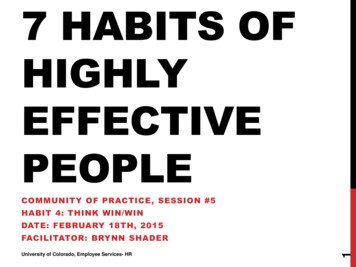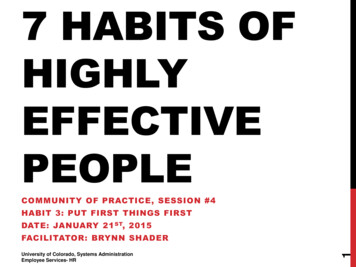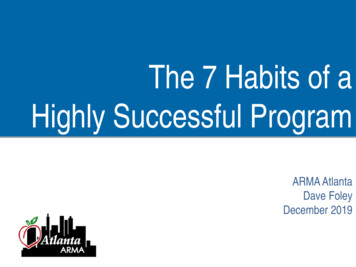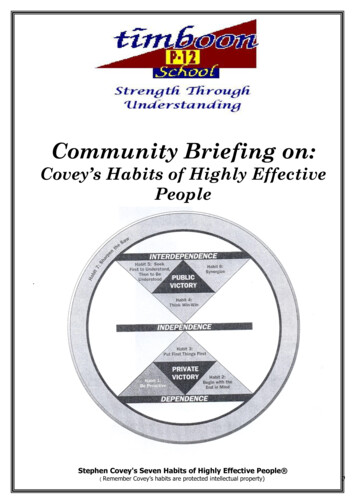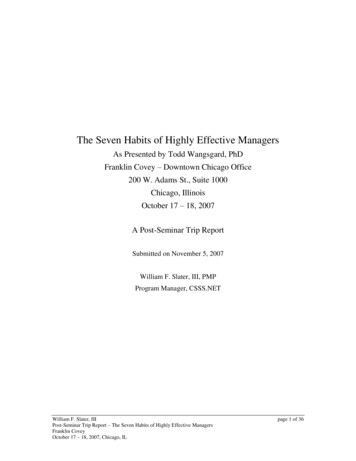
Transcription
The Seven Habits of Highly Effective ManagersAs Presented by Todd Wangsgard, PhDFranklin Covey – Downtown Chicago Office200 W. Adams St., Suite 1000Chicago, IllinoisOctober 17 – 18, 2007A Post-Seminar Trip ReportSubmitted on November 5, 2007William F. Slater, III, PMPProgram Manager, CSSS.NETWilliam F. Slater, IIIPost-Seminar Trip Report – The Seven Habits of Highly Effective ManagersFranklin CoveyOctober 17 – 18, 2007, Chicago, ILpage 1 of 36
Table of ContentsTable of Contents2Executive Summary3Introduction4What Are the Seven Habits of Highly Effective Managers?4Some Planning Tools for Highly Effective Managers6Application to My Present Position15Application to My Personal Life16Overall Opinion of the Class16Personal Reflection16Conclusion17Appendix A – Hidden Resource Finder18Appendix B – My Contribution Statement20Appendix C - 5-Minute Presentation Planner21Appendix E - Work Compass24Appendix F - Time Matrix – Quadrant Categorizer Tool25Appendix G – Four Management Mindsets, and Win-Win Performance Management 26Appendix H – Win-Win Performance Agreement28Appendix I – Emotional Bank Account30Appendix J – Feedback Facilitator30Appendix K – Empathic Listening Checklist31Appendix L – Empathic Listening Guidelines32Appendix M – Constructive Feedback Guideline Checklist33Appendix N – Third Alternative Finder34Appendix O – Team Member Survey – Four Dimensions of the Whole Person35William F. Slater, IIIPost-Seminar Trip Report – The Seven Habits of Highly Effective ManagersFranklin CoveyOctober 17 – 18, 2007, Chicago, ILpage 2 of 36
Executive SummaryThis report is a summary of the information, best practices, and tools I learned at theFranklin Covey Seminar on the Seven Habits of Highly Effective Managers. This twoday seminar was highly effective and practical because it presented a host of practicalideas for becoming a better, more productive person and a more effective professionalmanager.William F. Slater, IIIPost-Seminar Trip Report – The Seven Habits of Highly Effective ManagersFranklin CoveyOctober 17 – 18, 2007, Chicago, ILpage 3 of 36
IntroductionFrom October 17 – 18, 2007, I attended the Franklin Covey Management Training Seminar titled“Seven Habits of Highly Effective Managers” in Downtown Chicago. There were 16 participantsattending. The seminar was derived from the principles of Dr. Steven Covey’s bestsellingbusiness book, “the Seven Habits of Effective People.” It was excellent in every way. Amongthe highlights was training in some valuable tools that will help make me a more effectivemanager, along with some excellent concepts in leading people.In this report, I have strived to share what I learned from the seminar and also the actual tools wewere introduced to during the seminar. I know the things I learned in this seminar will benefit mefor the rest of my life. But it is my hope that others in our organization can also benefit from theideas and tools detailed in this paper.What Are the Seven Habits of Highly Effective Managers?The diagram below from Dr. Steven Covey’s bestselling business book, “the Seven Habits ofEffective People,” was the “roadmap” for the order in which the habits were presented.Figure 1 – The Stephen Covey Diagram of Seven Habits of Highly Effective PeopleWilliam F. Slater, IIIPost-Seminar Trip Report – The Seven Habits of Highly Effective ManagersFranklin CoveyOctober 17 – 18, 2007, Chicago, ILpage 4 of 36
The actual seven habits we reviewed are listed and summarized below.1. Be ProactiveUsing your resourcefulness and initiative to break the barriers to results.2. Begin with the End in MindMake the contribution you are capable of making.3. Put First Things FirstFocus on a few “wildly important goals” and track your progress.4. Think Win-WinMake Win-Win Performance Agreements to motivate superb performance.5. Seek First to Understand, Then to Be UnderstoodPractice Empathic Listening and give honest, accurate feedback6. SynergizeAlways see the Third Alternative – the truly creative solution or decision.7. Sharpen the SawUnleash the potential of your Team members by tapping the “whole person.”William F. Slater, IIIPost-Seminar Trip Report – The Seven Habits of Highly Effective ManagersFranklin CoveyOctober 17 – 18, 2007, Chicago, ILpage 5 of 36
Some Tools for Highly Effective ManagersThe following tools were explained and used with different student partners in the class.Tool NameHiddenResourceFinderArea1 – BeProactivePrimaryPurposeUsefulnessCommentsThis is avaluable aid forfindingresources toaccomplishtasks orprojects whenwe faceconstraints onresources,money or both.This isessentially abrainstormingtool to helpovercomeroadblockswhen tasks orprojects need toget done but theresource pool(s)have beenexhausted, orpeople aredenying youaccess to theresources youneed tocomplete yourobjectives.This is a quickway to tap intoadditionalresources thatyou may havepreviously notconsidered.William F. Slater, IIIPost-Seminar Trip Report – The Seven Habits of Highly Effective ManagersFranklin CoveyOctober 17 – 18, 2007, Chicago, ILpage 6 of 36
Tool onStatement2 – Begin withthe End inMindThis tool makesthe personfocus on whattheircontribution tothe organizationwill be, andthen put that inwriting.This is a usefultool because itmakes theperson thinkabout whattheircontributionwill be, andthen write itdown. If doneasrecommendedby theinstructor,sharing thecontributionstatement withothers,including theTeam and mymanager is apowerful formofcommunication.I wrote aContributionStatement onthe first day ofthe seminar. Ihave shared thisstatement, asrecommendedby theinstructor, withmy team andmy manager.5-MinuteMeetingPlanner2 – Begin withthe End inMindThis is a usefultool to ensurethat meetingsand planned,and that theyeach have apurpose.Proper use ofthis toolensures thatpeople’s timewill not bewasted, and thatthe managerwill be seen asbeing able toplan andorganize andmeeting.This is a usefultool. While Ialways have anagenda formeetings I planand conduct, Iwill probablyuse this toolalso from timeto time.William F. Slater, IIIPost-Seminar Trip Report – The Seven Habits of Highly Effective ManagersFranklin CoveyOctober 17 – 18, 2007, Chicago, ILpage 7 of 36
Tool esentationPlanner2 – Begin withthe End inMindThis tool makessure thatpresentationsare purposefuland to thepoint.This can beused forpresentationsdelivered bothinside work andoutside ofwork.It is a veryuseful tool,even if it is a bitsimplistic forlongpresentations.One of thereally usefulthings aboutthis tool is thechecklist ofpresentationrequirements atthe bottom ofpage one. Thiscan help ensurethat thepresenterdoesn’t forgetanything thatcould benecessary forthepresentation.5-MinuteProject Planner2 – Begin withthe End inMindThis is a veryhigh-level toolto define thepurposes of aproject and thehelp organizethe planningeffort.This tool canserve to quicklycommunicate tocolleagues in awell-organizedway, what thepurposes of aproject are, andit is onemethods to helpensure that theproject will beseen in apositive lightand that it willbe approved.This is helpfulin gettingstarted with aproject.William F. Slater, IIIPost-Seminar Trip Report – The Seven Habits of Highly Effective ManagersFranklin CoveyOctober 17 – 18, 2007, Chicago, ILpage 8 of 36
Tool NameAreaPrimaryPurposeUsefulnessCommentsWork Compass3 – Put FirstThings FirstThis tool, whenused at thebeginning ofeach week, willlist and focusthe individualon the “WildlyImportantGoals” (WIGs)as well as thekey objectivesto beaccomplishedunder each ofthe WIGs.When thisWork Compassis put in aprominentplace, such asthe individual’splanning book,it is useful to bea constantlyreminder aboutthe WIGs andthe keyobjectives to beaccomplishedduring thatweek. It alsoserves asdocumentationin the futureabout whatneeded to beaccomplishedduring a givenweek.I will be usingthis tool to helpme be betterorganized.Time Matrix –QuadrantCategorizerTool3 – Put FirstThings FirstThis tool helpsan individualunderstand thecategories ofthe dailyactivities thatthey areinvolved in, andhow some ofthose activitiescan be timewasters.Categorizingactivities in thismanner helpsme understandthe value ofQuadrant IIactivities andhow theseleadershipactivities canhelp avertcrises, andminimize timeand impact ofQuadrant IIactivities.This is a reallyuseful tool. Itmakes me morecommitted toplanning andspending mostof my timedoing QuadrantI and QuadrantII activities.William F. Slater, IIIPost-Seminar Trip Report – The Seven Habits of Highly Effective ManagersFranklin CoveyOctober 17 – 18, 2007, Chicago, ILpage 9 of 36
Tool mentMindsets andthe ContinuumsofConsiderationvs. Courage:4 – Think Win–WinThis tool helpsdefine the typesof interactionthat people canhave, and helpsmanagers bemindful ofcreatingsituations thatcan bedescribed asWin-Win.This toolgraphicallycategorizesthese mindsetsand serves as akind of cautionabout thenegative resultsof thesemindsets:The emphasison thecontinuums ofdegrees ofcourage andconsiderationrequired foreach of thesemindsets was auseful reminderto me about thedynamics andthe types ofeffort that gointo greement4 – Think Win–WinThis toolcaptures inwriting theprinciples ofthe Win-Winmindset, andestablishes theexpectations ofa Win-Winsituation andmethods toachieve them.This tool, in ahighlyorganized way,will helpcapture thenecessary stepsto create a WinWinperformanceand mindset. Italso serves asgooddocumentation,showing theintentions ofwhat isexpected, atimetable, andhow theprogress towardthese goals willbe measured.William F. Slater, IIIPost-Seminar Trip Report – The Seven Habits of Highly Effective ManagersFranklin CoveyOctober 17 – 18, 2007, Chicago, ILThis is anextremelyuseful tool andI will be usingit when I needit.page 10 of 36
Tool ank Account– MakingDeposits andWithdrawals4 – Think Win–WinThis tool is asimple checklistto help peopleunderstand theeffect ofbehaviors onthe trust levelsand quality ofrelationships.This can helppeopleunderstand theeffects of bothgood and badbehaviors andhow they canbuild up or teardownrelationshipsand the trustthat needs toexist in order tomake thingswork well in arelationship.This is a veryuseful tool,even thoughsome mightbristle at thename,“EmotionalBack Account.”FeedbackFacilitator5 – Seek Firstto UnderstandThen to beUnderstoodThis tool helpsprovideConstructiveFeedback in anorganized way.This is used toaccuratelycommunicateconstructivefeedback in anorganized way.This is a veryuseful tool but Ithink that itsuse could carrywith it somecareer limitingimplicationsand results.EmpathicListeningChecklist5 – Seek Firstto UnderstandThen to beUnderstoodThis covers theDo’s andDon’ts ofEmpathicListening.This is animportant toolto help anindividualunderstand theway they arelistening andprovidingfeedback wheninteracting witha person.I personallyfound this to beone of the mostchallengingconcepts in theseminar andone where Ineed morepractice.William F. Slater, IIIPost-Seminar Trip Report – The Seven Habits of Highly Effective ManagersFranklin CoveyOctober 17 – 18, 2007, Chicago, ILpage 11 of 36
Tool steningFramework5 – Seek Firstto UnderstandThen to beUnderstoodThis frameworkshows how togive feedbackduring aconversation sothat the personyou areinteracting withwill understandthat you areengaging inempathiclistening.This is veryuseful butrequires a greatdeal of thoughtand practice, atleast for me.(See ist5 – Seek Firstto UnderstandThen to beUnderstoodThis checklistcontains thevarious types ofFeedbackTechniques andcategorizesthem as Do’s orDon’ts, and itprovidesexamples ofwhat each ofthe types ofDo’s andDon’tsThis is veryuseful andrequirespractice.I will be usingthis tool atwork.William F. Slater, IIIPost-Seminar Trip Report – The Seven Habits of Highly Effective ManagersFranklin CoveyOctober 17 – 18, 2007, Chicago, ILpage 12 of 36
Tool NameThirdAlternativeFinderArea6 – SynergizePrimaryPurposeUsefulnessCommentsThis tool helpsa manager findotheralternativeswhen a problemneeds to besolved.This tool isvery usefulbecause it helpsyou come upwith othersolutions thatcan better solvea problem, butwhich had notbeen previouslyconsidered.While this is auseful tool, Iprobably won’tbe using it morethan once ortwice a month,because thechallenges Ihave are notconducive tohaving thesolutionsworked out inthis manner.Somethingabout the way agovernmentposition addsstructure cancreate aframework ofbureaucracythat doesn’tpermit the useof such tools.William F. Slater, IIIPost-Seminar Trip Report – The Seven Habits of Highly Effective ManagersFranklin CoveyOctober 17 – 18, 2007, Chicago, ILpage 13 of 36
Tool NameAreaPrimaryPurposeUsefulnessCommentsTeam MemberSurvey: TheFourDimensions ofthe WholePerson7 – Sharpen theSawThis tool helpsa managerunderstand thata person mustbe understoodand viewedfrom thedimensions ofHeart, Mind,Body andSpirit.If Teammembers openup and sharethe ideas listedin this survey, itwill help themanagerunderstandthem better as aperson. If youunderstandpeople better,you can relateto them betterand lead themmoreeffectively.I shared thissurvey with mytool and twohave alreadyresponded.William F. Slater, IIIPost-Seminar Trip Report – The Seven Habits of Highly Effective ManagersFranklin CoveyOctober 17 – 18, 2007, Chicago, ILpage 14 of 36
Application to My Present PositionAmong the most important principles discussed that can help me be a more effectivemanager: You manage things not people. You lead and inspire people to accomplish themission. You need to get your own house in order before you can be an effective leaderand lead others. Great leaders trust their people, inspire, equip, and em
Franklin Covey October 17 – 18, 2007, Chicago, IL The Seven Habits of Highly Effective Managers As Presented by Todd Wangsgard, PhD Franklin Covey – Downtown Chicago Office 200 W. Adams St., Suite 1000 Chicago, Illinois October 17 – 18, 2007 A Post-Seminar Trip Report Submitted on November 5, 2007 William F. Slater, III, PMP Program Manager, CSSS.NET . William F. Slater, III page 2 of 36 .


